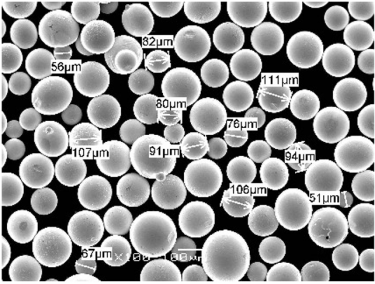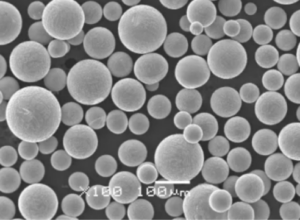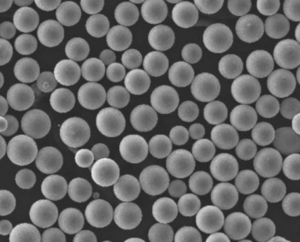개요 레이저 엔지니어링 네트 성형 (렌즈)
일반적으로 LENS라고 알려진 레이저 엔지니어링 네트 쉐이핑은 고출력 레이저를 사용하여 복잡한 고성능 금속 부품을 제작하는 고급 적층 제조 기술입니다. 기존 제조 방식과 달리 LENS는 금속 분말을 녹여 층별로 증착하는 방식으로 3D 구조물을 직접 제작할 수 있는 것으로 유명합니다.
LENS의 다용도성 덕분에 항공우주, 방위 및 생의학 분야와 같이 우수한 기계적 특성을 지닌 복잡한 금속 부품이 필요한 산업에서 특히 유용합니다. 그렇다면 LENS가 다른 제조 방식과 정확히 무엇이 다를까요? 그리고 다음 프로젝트에 이 방법을 사용해야 하는 이유는 무엇일까요? LENS의 매혹적인 세계에 대해 자세히 알아보세요.

LENS는 어떻게 작동하나요?
조각품을 만들 때 돌덩어리를 깎아내는 대신 원하는 모양이 나올 때까지 재료를 한 층씩 쌓아 올린다고 상상해 보세요. 이것이 바로 LENS의 본질입니다. 단계별 분석은 다음과 같습니다:
- 레이저 빔 초점: 고출력 레이저 빔이 기판에 집중됩니다.
- 금속 분말 주입: 분말 전달 노즐을 사용하여 레이저 빔의 초점에 금속 분말을 주입합니다.
- 용해 및 응고: 레이저가 금속 분말을 녹이고 냉각되면서 응고되어 새로운 층을 형성합니다.
- 레이어별 구성: 이 프로세스는 컴퓨터로 생성된 디자인에 따라 부품을 레이어별로 쌓아 올리면서 반복됩니다.
LENS의 장점:
- 정밀도: LENS는 복잡한 형상과 미세한 디테일이 있는 부품을 제작할 수 있습니다.
- 재료 효율성: 필요한 곳에만 자료를 추가하기 때문에 낭비가 최소화됩니다.
- 사용자 지정: 부품을 즉석에서 사용자 지정할 수 있어 프로토타이핑 및 맞춤형 제조에 이상적입니다.
렌즈에 사용되는 재료: 금속 분말
LENS의 가장 흥미로운 측면 중 하나는 다양한 금속 분말을 사용할 수 있다는 점입니다. 이러한 파우더는 LENS 공정을 위해 특별히 설계되어 일관된 성능과 고품질의 최종 제품을 보장합니다.
렌즈에 사용되는 일반적인 금속 분말
| 금속 분말 | 구성 | 애플리케이션 | 고유 속성 |
|---|---|---|---|
| 티타늄 합금(Ti-6Al-4V) | 90% 티타늄, 6% 알루미늄, 4% 바나듐 | 항공우주, 생체의학 임플란트 | 높은 중량 대비 강도, 내식성 |
| 인코넬 718 | 니켈, 크롬, 철 | 항공우주, 터빈 블레이드 | 높은 내열성, 내구성 |
| 스테인리스 스틸 316L | 철, 크롬, 니켈 | 의료 기기, 해양 애플리케이션 | 내식성, 생체 적합성 |
| 알루미늄 6061 | 알루미늄, 마그네슘, 실리콘 | 자동차, 항공우주 | 가볍고 우수한 기계적 특성 |
| 코발트-크롬(CoCr) | 코발트, 크롬, 몰리브덴 | 치과 임플란트, 가스 터빈 | 내마모성, 고강도 |
| 마레이징 스틸(18Ni300) | 철, 니켈, 코발트 | 툴링, 항공우주 | 초고강도, 손쉬운 열처리 |
| 텅스텐 카바이드(WC-Co) | 텅스텐, 코발트 | 절삭 공구, 채굴 장비 | 극한의 경도, 내마모성 |
| 구리 합금(CuCrZr) | 구리, 크롬, 지르코늄 | 전기 부품, 열교환기 | 뛰어난 열 전도성, 강도 |
| 하스텔로이 X | 니켈, 몰리브덴, 크롬 | 화학 처리, 제트 엔진 | 내산화성, 고강도 |
| 공구강(H13) | 철, 탄소, 크롬 | 금형, 금형, 툴링 | 인성, 내마모성 |
렌즈용 일반적인 금속 분말의 구성
렌즈용 금속 분말을 선택할 때는 각 재료의 특정 조성을 이해하는 것이 중요한데, 이는 기계적 특성과 다양한 용도에 대한 적합성에 직접적인 영향을 미치기 때문입니다.
금속 분말의 세부 구성
| 금속 분말 | 기본 요소 | 추가 요소 | 일반적인 애플리케이션 |
|---|---|---|---|
| 티타늄 합금(Ti-6Al-4V) | 티타늄(90%) | 알루미늄(6%), 바나듐(4%) | 항공우주, 의료용 임플란트 |
| 인코넬 718 | 니켈(50-55%) | 크롬(17-21%), 철(5-9%) | 터빈, 제트 엔진 |
| 스테인리스 스틸 316L | 다리미(60-65%) | 크롬(16-18%), 니켈(10-14%) | 해양, 생체의료 기기 |
| 알루미늄 6061 | 알루미늄(97-98%) | 마그네슘(0.8-1.2%), 실리콘(0.4-0.8%) | 자동차, 항공우주 |
| 코발트-크롬(CoCr) | 코발트(55-65%) | 크롬(26-30%), 몰리브덴(5-7%) | 치과, 가스 터빈 |
| 마레이징 스틸(18Ni300) | 다리미(60-65%) | 니켈(18-20%), 코발트(7-8%) | 툴링, 항공우주 |
| 텅스텐 카바이드(WC-Co) | 텅스텐(85-90%) | 코발트(6-10%) | 절삭 공구, 채굴 |
| 구리 합금(CuCrZr) | 구리(96-98%) | 크롬(0.5-1.2%), 지르코늄(0.1-0.2%) | 전기, 열교환기 |
| 하스텔로이 X | 니켈(47-52%) | 몰리브덴(8-10%), 크롬(20-23%) | 화학, 제트 엔진 |
| 공구강(H13) | 다리미(85-90%) | 탄소(0.32-0.45%), 크롬(4.75-5.5%) | 금형, 툴링 |






렌즈 생산 부품의 특성
렌즈 기술은 기존 방식으로 만든 부품과 차별화되는 고유한 특성을 가진 부품을 생산하는 것으로 유명합니다. 이러한 부품을 특별하게 만드는 요소를 살펴볼까요?
렌즈 구성 요소의 주요 특성
| 특징 | 설명 | 혜택 |
|---|---|---|
| 높은 정밀도 | LENS는 복잡한 디테일과 엄격한 공차를 가진 부품을 생산할 수 있습니다. | 복잡한 디자인에 이상적입니다. |
| 우수한 재료 특성 | LENS 공정은 강도 및 내구성과 같은 소재의 특성을 향상시킬 수 있습니다. | 까다로운 애플리케이션에서 더 나은 성능을 제공합니다. |
| 최소한의 후처리 | 렌즈 부품은 후처리가 거의 또는 전혀 필요하지 않은 경우가 많습니다. | 제작 시간과 비용을 절감합니다. |
| 다양한 소재의 활용성 | LENS에는 다양한 금속 분말을 사용할 수 있습니다. | 작업에 적합한 자료를 유연하게 선택할 수 있습니다. |
| 레이어별 구성 | 부품은 레이어별로 제작되므로 최종 모양을 정밀하게 제어할 수 있습니다. | 디자인 사용자 지정 및 미세 조정. |
렌즈 기술의 응용
LENS 기술은 그 고유한 기능으로 인해 다양한 산업 분야에서 채택되고 있습니다. 아래는 다양한 분야에서 LENS의 주요 적용 분야를 보여주는 표입니다:
렌즈 기술의 산업 응용 분야
| 산업 | 특정 애플리케이션 | 렌즈 사용의 장점 |
|---|---|---|
| 항공우주 | 터빈 블레이드, 구조 부품, 마모된 부품 수리 | 경량, 고강도 부품, 수리 용이성 |
| 의료 | 맞춤형 임플란트, 치과 보철물 | 생체 적합성 소재, 정밀성, 맞춤화 |
| 자동차 | 경량 부품, 프로토타이핑 | 신속한 프로토타이핑, 재료 효율성 |
| 방어 | 갑옷 구성품, 무기 시스템 | 향상된 내구성, 복잡한 형상 |
| 에너지 | 터빈 부품, 열교환기, 연료 전지 | 높은 내열성, 재료 효율성 |
| 툴링 | 금형, 금형, 절삭 공구 | 내구성, 내마모성, 리드 타임 단축 |
| 석유 및 가스 | 다운홀 공구, 밸브, 펌프 | 내식성, 재료 강도 |
| 전자 제품 | 방열판, 전도성 부품 | 열 전도성, 정밀 엔지니어링 |
| 해양 | 프로펠러 샤프트, 러더 부품, 펌프 부품 | 내식성, 강도 |
| 화학 처리 | 원자로 부품, 열교환기 | 내식성, 고온 성능 |
렌즈의 사양, 크기, 등급 및 표준
LENS 기술로 작업할 때는 금속 분말 및 구성 요소와 관련된 사양, 크기, 등급 및 표준을 이해하는 것이 중요합니다.
렌즈 재질에 대한 사양 및 표준
| 재료 | 사양/등급 | 표준 | 일반적인 크기 |
|---|---|---|---|
| 티타늄 합금(Ti-6Al-4V) | ASTM F1472, 5등급 | ASTM 국제 | 분말: 15-45 µm |
| 인코넬 718 | AMS 5662, UNS N07718 | SAE 국제 | 분말: 10-53 µm |
| 스테인리스 스틸 316L | ASTM A240, UN S31603 | ASTM 국제 | 분말: 10-45 µm |
| 알루미늄 6061 | ASTM B209, UN A96061 | ASTM 국제 | 분말: 15-63 µm |
| 코발트-크롬(CoCr) | ASTM F75, UNS R30075 | ASTM 국제 | 분말: 15-45 µm |
| 마레이징 스틸(18Ni300) | AMS 6514, UNS K93120 | SAE 국제 | 분말: 10-45 µm |
| 텅스텐 카바이드(WC-Co) | ISO 9001:2008 | ISO 표준 | 분말: 20-70 µm |
| 구리 합금(CuCrZr) | ASTM B422, UN C18150 | ASTM 국제 | 분말: 10-45 µm |
| 하스텔로이 X | AMS 5754, UNS N06002 | SAE 국제 | 분말: 15-53 µm |
| 공구강(H13) | ASTM A681, UN T20813 | ASTM 국제 | 분말: 10-45 µm |
LENS의 장점과 한계
LENS 기술은 다양한 이점을 제공하지만 그 한계를 인식하는 것도 중요합니다. 다음은 비교입니다:
렌즈의 장점과 한계
| 장점 | 제한 사항 |
|---|---|
| 높은 정밀도 | 비용: 렌즈는 관련된 장비와 재료로 인해 비용이 많이 들 수 있습니다. |
| 재료 효율성 | 복잡성: 이 프로세스는 기술적으로 복잡하며 숙련된 운영자가 필요합니다. |
| 사용자 지정 | 표면 마감: 원하는 표면 마감을 얻기 위해 부품에 추가 후처리가 필요할 수 있습니다. |
| 다양한 소재 | 크기 제한: 렌즈는 일반적으로 공정의 특성상 작은 부품으로 제한됩니다. |
| 수리 가능성 | 속도: 렌즈는 대량 생산 시 다른 제조 방식에 비해 속도가 느릴 수 있습니다. |
| 향상된 기계적 특성 | 초기 설정: 높은 초기 설정 비용은 소규모 비즈니스에 장벽이 될 수 있습니다. |
LENS와 다른 적층 제조 기술 비교
LENS는 종종 직접 금속 레이저 소결(DMLS) 및 선택적 레이저 용융(SLM)과 같은 다른 적층 제조 방법과 비교됩니다. 차이점을 자세히 알아보겠습니다:
렌즈와 다른 적층 제조 방법 비교
| 기능 | 렌즈 | DMLS | slm |
|---|---|---|---|
| 재료 범위 | 고성능 합금을 포함한 광범위한 제품군 | 주로 금속, 이국적인 소재는 적음 | 렌즈와 유사한 넓은 범위 |
| 정밀도 | 높이, 세밀한 디테일 가능 | 매우 높아 복잡한 디자인에 이상적 | LENS와 비슷한 수준, 높음 |
| 비용 | 고가 부품을 위한 고비용 설정, 비용 효율적 | 적당히 비싼 | 렌즈와 유사하게 소재에 따라 |
| 속도 | 보통, 복잡한 부품에 적합 | 일반적으로 작은 부품의 경우 더 빠름 | 특정 애플리케이션에서 LENS보다 빠른 속도 |
| 후처리 | 최소 요구 사항 | 일부 후처리 필요 | 상당한 후처리가 필요함 |
| 애플리케이션 | 항공우주, 의료, 툴링 | 항공우주, 자동차, 의료 | 항공우주, 의료, 산업 |
렌즈 재료의 공급업체 및 가격 세부 정보
LENS 자료의 출처와 관련 비용을 파악하는 것은 프로젝트 예산과 계획을 세우는 데 매우 중요합니다.
렌즈 재료 공급업체 및 가격
| 재료 | 공급업체 | 대략적인 kg당 가격 |
|---|---|---|
| 티타늄 합금(Ti-6Al-4V) | 카펜터 기술, 올리콘 AM | $300 – $500 |
| 인코넬 718 | 프렉스에어 표면 기술, 샌드빅 | $150 – $300 |
| 스테인리스 스틸 316L | 샌드빅, 카펜터 테크놀로지 | $50 – $100 |
| 알루미늄 6061 | 올리콘 AM, LPW 기술 | $30 – $60 |
| 코발트-크롬(CoCr) | Arcam AB, 샌드빅 | $400 – $600 |
| 마레이징 스틸(18Ni300) | LPW 기술, EOS GmbH | $200 – $350 |
| 텅스텐 카바이드(WC-Co) | H.C. 스탁, 글로벌 텅스텐 및 분말 사업부 | $500 – $700 |
| 구리 합금(CuCrZr) | 샌드빅, 프렉스에어 표면 기술 | $100 – $200 |
| 하스텔로이 X | 카펜터 기술, LPW 기술 | $300 – $500 |
| 공구강(H13) | EOS GmbH, LPW 기술 | $50 – $100 |

자주 묻는 질문
| 질문 | 답변 |
|---|---|
| LENS는 어떤 용도로 사용되나요? | LENS는 고성능 금속 부품을 제조하고, 마모된 부품을 수리하고, 프로토타입을 제작하는 데 사용됩니다. |
| LENS는 기존 제조업과 어떻게 다른가요? | LENS는 금속 분말로 부품을 한 층씩 제작하기 때문에 기존 방식에 비해 정밀도와 재료 효율성이 뛰어납니다. |
| LENS에 어떤 재료를 사용할 수 있나요? | 티타늄 합금, 스테인리스 스틸, 알루미늄, 니켈 기반 초합금 등 다양한 금속 분말을 사용할 수 있습니다. |
| LENS는 비용 효율적인가요? | 렌즈는 고가의 복잡한 부품에는 비용 효율적일 수 있지만 단순하고 대규모로 생산할 때는 비용이 많이 들 수 있습니다. |
| LENS의 혜택을 가장 많이 받는 산업은 무엇인가요? | 항공우주, 의료, 자동차, 방위 산업은 LENS가 제공하는 정밀도와 맞춤화의 이점을 크게 누리고 있습니다. |
| LENS에는 크기 제한이 있나요? | 예, LENS는 일반적으로 소형 부품에 더 적합하지만 기술의 발전으로 그 기능이 확장되고 있습니다. |
| LENS는 다른 적층 제조 방법과 비교하면 어떤 점이 다른가요? | LENS는 우수한 재료 특성과 사용자 지정 기능을 제공하지만 DMLS나 SLM과 같은 방법보다 속도가 느리고 비용이 더 많이 들 수 있습니다. |
| LENS의 주요 과제는 무엇인가요? | 높은 초기 설정 비용, 기술적 복잡성, 숙련된 운영자의 필요성은 일반적인 문제입니다. |
| LENS를 대량 생산에 사용할 수 있나요? | LENS는 특수한 고부가가치 부품에 이상적이지만, 속도가 느리고 비용이 높아 일반적으로 대량 생산에는 사용되지 않습니다. |
| LENS 부품에는 어떤 후처리가 필요하나요? | 렌즈 부품은 일반적으로 최소한의 후처리가 필요하지만, 애플리케이션에 따라 표면 마감이 필요할 수 있습니다. |

